Cavitation as a Purification Panacea?
The Italian company, Biokavitus has perfected the process of cavitation to the point of now launching several commercial products into the market. And they are open sourcing the core concept to help speed the cleaning of the planet, including nuclear waste, wastewater, oil contamination, but also home cleaning applications. There are health benefits as well - of all living organisms.
Historically, by nature, water is purified by rolling over rocks. Could it be that this introduces natural cavitation effects that are mimicked by this technology that reintroduces this natural phenomenon at the point of use, reinvigorating water?
 Inventor, Andrea Rampado, with associate Roberto Mezzano of Biokavitus |
by
Sterling D. Allan
Pure Energy Systems News
A couple of weeks ago, I nearly blocked a new contact at Skype who
seemed to be doing small talk but nothing more. He asked to become a
contact on October 6, the day Andrea Rossi was doing a test of his cold
fusion E-Cat module in Bologna. I had asked for contacts from the event
who might be able to give us live reports. Since he was from Italy, I
presumed he might be one such person.
He wasn't, but it turns out that he is one of the most amazing contacts
I've ever made, and a source of personal satisfaction for all these
years of diligent effort in posting free energy news, because he says he
got his start from watching a video from a link in our news ten years
ago. Now he has a company with 18 personnel, taking a product to market.
He's so grateful for that introduction a decade ago, he has been
treating me like a celebrity; yet before he got into this endeavor, he
himself was a celebrity, making gobs of money in marketing. He decided
to change his focus to making a difference on the planet, and not just
making money.
I'm talking about Andrea Rampado of Biokavitus (Bio Cavitation) in
Italy. I met him and his associate, Roberto Mezzano, on a Skype video
conference a couple of weeks ago; and then in person when I was in
Bologna for Andrea Rossi's E-Cat test. Mezzano translated for us.
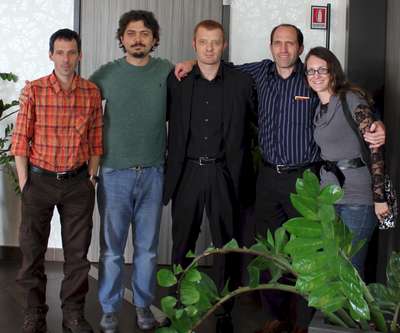 From L to R: Paolo Savaris; Roberto Mezzano, Andrea Rampado, Sterling Allan, Cheri Allan |
They have become foremost experts in the subject, methods, and
applications of cavitation.
He and his team have so much going that I hardly know where to start
this report to you, or what to title this. There are at least 6 separate
stories I could write about them, each of them being of a breakthrough
nature. And in the coming days, I suspect that these various facets will
be more fully articulated, either by myself or by others, as I bring
this company to your attention.
How it Works
Usually, when we hear the word "cavitation", we immediately think of the
destructive properties of extremely rapidly-moving water. True to one of
their favorite sayings, by Galileo, "Behind every problem lies an
opportunity," this company has figured out how to provide a wealth of
solutions using the beneficial properties of cavitation. And there are
some amazing benefits to be had.
In their case, rather than using cavitation from fast volumes of water,
they harness what they call the "soft cavitation" that comes when tiny
microspheres of water implode. By 'microspheres', I'm referring to
bubbles of air in sizes between 50 nm and 50 micrometers. The smaller
the bubbles, the stronger their effect. A 50nm bubble, compared to a
standard 5mm aerator bubble, results in a 100 thousand increase in its
specific surface area relative to its medium.
Water infused with these microbubbles works well in cleaning as well as
having anti-bacterial properties. And the amount of energy required to
create the bubbles is miniscule compared to their beneficial effects.
In chemical reactions, there are three main factors: a) temperature, b)
surface area, and c) agitation. These cavitating microbubbles address
all three. Their implosion action results in an increase in temperature
and agitation; and the nano-micro size addresses the surface area.
Bubbles smaller than 50 micrometers don't rise through the water like
the bubbles we usually think of; but they stay diffused in the water --
Brownian motion -- so their life span is very long.
The bubbles can also have a negative or positive ionic charge to them,
adding to their range of properties.
When the water fills with microbubbles of air, the water takes on a
white appearance.
Rampado listed eight different methodologies for creating cavitation:
mechanical, hydrodynamical, magnetostructive, ultrasonic, laser, ion,
microwave, electromagnetic. Having investigated and personally inspected
all of these methods, his company has developed a know-how on applying
different methods to obtain cavitation in different applications.
More specifically, for wastewater treatment they have chosen the
hydrodynamical method, using a simple venturi principle. There are no
moving parts, other than what may be involved separately in pressurizing
the water to run through their apparatus.
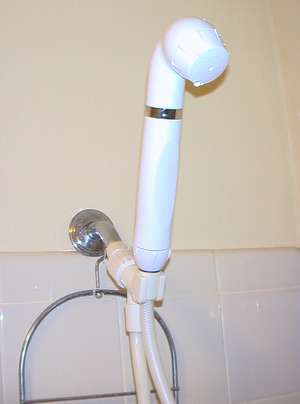 Biokavitus shower head installed in my bathroom. 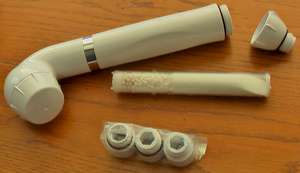 Head includes a filter mechanism. 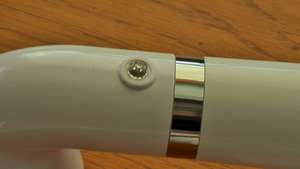 Venturi opening at top. |
![]()
Applications
When we met in Bologna on Saturday, they gave my wife and me a
shower head that uses regular water pressure to infuse these micro
bubbles into the water, resulting in water that feels warmer (due to
their high kinetic action), and cleans more deeply, penetrating deep
into the pours, dramatically reducing the need of soap. This results in
using approximately 30% less water; as well as a reduction in the amount
of water that needs to be heated as well as the temperature to which the
water needs to be run in the shower. Less water and lower temperatures
means cost savings.
It's a great looking appliance, but they aren't even selling it. They
give it to their potential customers as a conversation piece and
demonstration piece to make their point about the main application they
are approaching the customer about.
One incidental thing I should mention that they told me is that the
shower head gives off a certain tone, whose pitch is dependent on the
speed or pressure of the water going through it.
My Personal Use Experience
This morning, November 5, 2011, I took a shower for the first time using this Biokavitus shower head. Here are some of my observations, as well as those of my wife and son who also have used the new shower head.
- The aperture of the shower head is very pleasant, giving the impression of a higher-flow of water, given the same volume. It gives a wide dispersal and a powerful feel.
- We can confirm that we did get away with using at least half the normal volume of soap/shampoo/body wash.
- My wife says her skin feels smoother.
- We feel cleaner after the shower, compared to before using this shower head.
- The sound/tone it makes is quite loud. You can hear it outside the bathroom. This can have an advantage inasmuch as it distinguishes the sound of water running in the sink or tub as opposed to the shower.
- As for temperature, I actually turned the heat up higher than before to get the same apparent water temperature; so that portion did not validate.
But the applications are much more than that.
For home applications, this can be used for dishwashers, clothes washing
machines as well as general cleaning.
They say it can also be used as drinking water; so conceivably you could
treat the mains water coming into the home. For example, the cavitation
process removes Chlorine from the water. In the Skype video call, they
showed a fish tank in their office that has the bubbles going into it.
The fish seemed content. Furthermore, the fish grow faster and are
healthier. And no antibiotic is needed for the water because of the
anti-bacterial properties of the microbubbles. But what is more
astonishing is that the bubbled water enables saltwater fish and
freshwater fish to live together in water with 1gr/liter of salt inside.
Rampado said that they have used the water for growing plants as well,
and have found that they grow better, larger, faster; and the fruits
taste sweeter. Here's a
video showing a
time-lapsed difference between a control (left) and plants grown with
their water (right).
Cavitation can also be used for inexpensive and effective
pasteurization without heat.
Rampado showed me a video of them making whipped cream using cavitation.
It "stays inflated for weeks," and no preservatives are needed, since
the bubbles also prevent bacterial growth.
I asked them about what the water might do for beneficial bacteria that
reside on our bodies, including the skin and in our digestion tracts.
They said it was fine -- something about the "gentler" version of the
cavitation leaving them in tact. But it seemed to me that they had not
properly delved into and addressed this question, and that it could be
the primary down-side to foods and drinks being treated in this manner,
for human consumption. We need our good bacteria. [See follow-up
clarification from Rampado
below.]
Rampado said the water cavitated with oxygen bubbles has also been shown
to be more effective than hypobaric treatment for burn victims.
The purifying and anti-bacterial properties of the water make it a great
candidate for wastewater treatment plants. Here is where the costs
reductions really can make a big difference -- between 85 and 95%
savings, as well as the effectiveness.
Given the three attributes of microbubbles: a) temperature, b) surface
area, and c) agitation; you can imagine that it would have a zillion
applications in chemistry as well. For example, it can conserve up to
90% energy otherwise required for some chemical reactions.
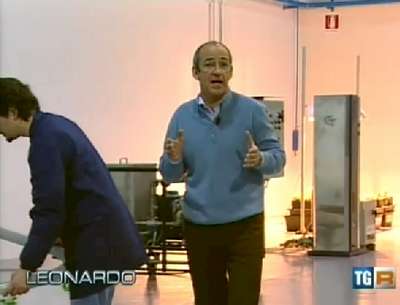 Biokavitus' nuclear remediation device is shown in the background, right, in this segment from the Leonardo TV series. |
But its action is not limited to chemistry. Think nuclear
remediation. Rampado says the cavitation effect can treat nuclear waste,
reducing the half-life span by 10,000 times, thus accelerating
radioactive decay. As a footnote, I should mention that when we met in
Bologna, they had Paolo Savaris <p.savaris@vm-kreas.it>
with them, who has developed a method of accelerating doing nuclear
decay without also accelerating the nuclear emissions involved during
that decay. He has a proof of concept prototype that can be shown.
Rampado once visited a facility that used cavitation to remove CO2 from
a power plant emission, splitting the CO2 into carbon and oxygen; and
the carbon was fed back into the feedstock to be burned again, greatly
improving the efficiency of the plant, while essentially eliminating the
CO2 emissions.
He said that cavitation technology can also benefit the production of
biodiesel, facilitating nearly every step, resulting in a 80-90% energy
savings in the production process. The savings from implementing this in
Europe, for example, would be enough to remove 1.6 nuclear power plants
from that grid.
Cavitation can also be used for rapidly and efficiently separating oil
from water. This is great news for people effected by oil spills. Here's
a video
demonstrating the separation of oil from water.
The Russians use cavitation in torpedoes to increase the speed at
which they can go through the water -- 800 kph. This is done by a nozzle
at the tip of the torpedo that is vibrated to create a cushion of
cavitation bubbles that act as a lubricant for the missile as it slides
through the water. The U.S. Navy introduced its "ghost ship" that uses a
similar method on its catamaran runners, enabling the craft to speed
along at 100 mph.
I can't help but wonder how microbubble water might behave in the
various electrolysis paradigms people are using in hydroxy research and
development. Will it augment the net power output? How much?
What about cold fusion? Will it augment what goes on in the reaction
chamber?
At some point, Rampado envisions using the cavitation of a solid/liquid
mixture for the purpose of energy generation. He didn't elaborate how he
sees that happening.
"Every place there are liquids, we have a solution", Rampado said,
adding that they have become the premier experts worldwide in
cavitation.
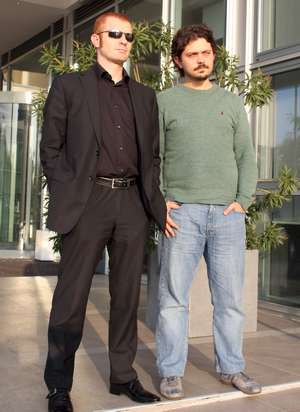 Andrea Rampado and Roberto Mezzano posing as X-Men. |
![]()
About Biokavitus
Rampado has spent 10 years doing research and development in
cavitation, spending 4 million Euros so far, two of that being in the
past two years.
Prior to that, he was a very successful marketer, but he left that world
to pursue something that he felt would have a more positive effect on
mankind. "In marketing, one of the primary tools is to instill in your
customer the 'need' for your product. But with this product, that is
already well established."
"I want to cavitate the entire world," Rampado said in humor.
In September, they began going to market with their products; but they
plan to continue to spend between 20 and 30% of their budget on research
and development. This is an order of magnitude more than the average of
3.1% across all industries; and two orders of magnitude more than the
0.3% that the energy spends of their budget on R&D.
Of the 18 personnel on Biokavitus payroll, six of them are working
full-time in their present facility, which is 800 square meters.
They showed me their plans for the new building they plan to build and
move into by September of next year. It entails two floors of warehouse
of 10,000 square meters each floor. The roof will be covered with solar
panels to provide 250 kW of electrical power and 600 kW of heat; and
they also will be implementing some more exotic energy generation
methods as well. A partner company will be occupying the first floor.
Here is a video I shot of my Skype video call on October 12 with Rampado
and Mezzano. Forgive the quality, as I was just filming my computer
screen.
In this first
segment, Rampado and Mezzano describe their technology showing the
very basic component; followed by showing me several of their production
line products in their warehouse, beginning with a nuclear remediation
product; as well as device for the treatment of oil-water emulsions
separation device and a biofuel plant capable of producing 4000 tons of
biodiesel per year [about ½ ton/hour constantly produced], running off
of 10 kW of power, so 20 kWh/tons of biodiesel are immediately produced;
and a Russian patented device that separates oil and water . They also
show and describe their fish tank with the microbubbles diffusing into
it.
In this next segment Rampado and Mezzano show and describe several videos about their technology that are on YouTube, including two instances (1 | 2) where they were featured on the Italian TV show "Leonardo". The first video shows plants' accelerated growth when given the microbubble water. The next video shows oil-water separation. Then is their appearance on "Leonardo", called "Cavitazione", showing a demonstration of separating water and oil from a container that had both in it. Then their "Leonardo" appearance titled "Neutroni da rocce compresse" showing the effect that cavitation had on material strength.
|
|
The next, short segment, mentions their interest in Andrea Rosse's E-Cat technology and how they think their technology sheds some light on his process, and could be used to augment his effect of fusing hydrogen and nickel atoms into copper at relatively low temperatures and pressures, producing copious amounts of energy. Don't get your hopes up, the segment basically says, "we should write that up." They explained it earlier in our call, before I had the video camera turned on.
Finally, in the last short segment, Rampado proudly shows off the Bedini electromagnetic device he built, which he says achieved 2.5x overunity. He also expresses his appreciation for our news service and the role it played in fostering his thinking over the past decade.
Added to 'Top Exotic Energy Technologies' Listing
I'm going to be adding Biokavitus to our listing of the "Best
Exotic Free Energy Technologies" now emerging into the marketplace.
They are not in the energy production sector, but they fit well in the
energy conservation genre. And they get the distinction of being listed
among the heading, along with the E-Cat, of those who are now in the
marketplace.
To know that they were so influenced by our news, and to see how well
they are doing now, gives me a great deal of personal satisfaction.
I am hoping that the success of their technology in the quasi open
source world will demonstrate to many other inventors, including Andrea
Rossi, that open sourcing can be a very productive and financially
empowering method of deploying a technology into the marketplace. They
don't need it; they say; they are doing fine; but they are glad to play
this pioneering role, and have agreed to let us help coordinate that.
I predict that "Biokavitus" will have a prominent name in this chapter
of world history, when so much hangs in the balance. "They helped clean
up the planet, cleaning up the nuclear waste, cleaning up the water,
improving the health of the water and of the people and organisms who
drink the water, improving the quality and quantify of agriculture,
making a myriad of processes much more efficient, thus saving vast
amounts of energy, and eventually even coming up with inexpensive and
sustainable energy generation plants. And they did it rapidly and
efficiently by deploying the people of the world into a vast array of
self-starting companies, creating a productive capacity that helped pull
the world economy from the brink of disaster."
# # #
This story is also published at
BeforeItsNews.
Clarification from Andrea Rampado
On November 6, 2011, in response to the question about friendly
bacteria, Rampado wrote:
(Translated by Google, with some editing.)
| Eliminating the bacteria from a liquid substance does not
mean that then the same becomes a bactericidal substance. The deletion in our case can be made in two distinct phenomena: the first is the power that is using a very driven cavitation that destroys the cell membranes with the shock waves created by the implosion of the bubbles (see, e.g., cavitation aesthetic), the second drive that produces much less micro-nanobubbles positively or negatively charged (may predetermine). The negative electrostatic charge combined with hyperoxygenation (up to 3 times) creates a toxic and lethal liquid environment for anaerobic bacteria by promoting the proliferation of aerobic bacteria, unlike positive and using CO2 instead of air or pure oxygen creates a liquid environment poisonous and deadly for aerobic organisms favoring the proliferation of anaerobic organisms. The confusion that has resulted in demand is that your explanations provide confusion between systems that are used for the treatment of industrial liquid and easy to use spray producing an aesthetic water that can be safe to drink, and is certainly not an antibiotic. To better help you understand, the emulsions used as coolants during the industrial production of mechanical parts in a short time as a result of anaerobic decay and then goes into the liquid must be disposed (only in Europe; is a market of 2.8 billion Euros). With nearly the same energy that is used to recirculate these liquids during operation of machine tools, we are able to enter a special cavitation that can produce different phenomena; hyperventilation and ionization that sterilize and at the same time prevent the proliferation of bacteria anaerobes, and thus the flotation separation of solids and the separation of micropollutants foreign oil. The result is a continuous regeneration of the emulsion and thus no longer discarded. Energy savings, product and thus a great savings. And the ability to pasteurize any liquid less than 40 ° C, as another interesting phenomenon is that you can wash at room temperature, dramatically reducing the use of detergents and much more. |
www.pureenergysystems.com
PES Network, Inc.
Copyright © 2003 - 2011